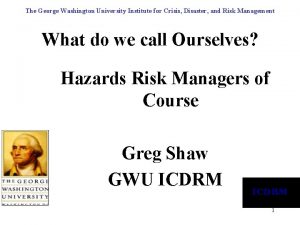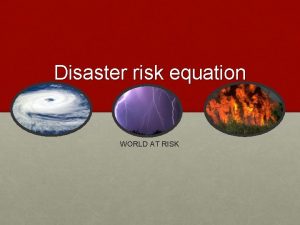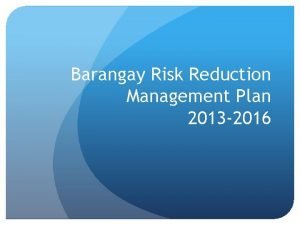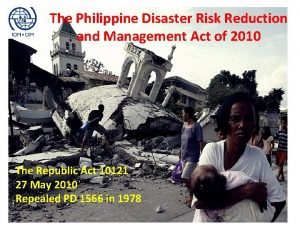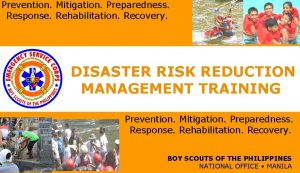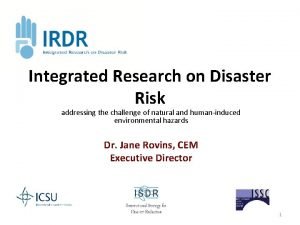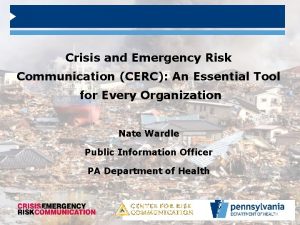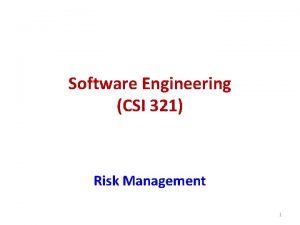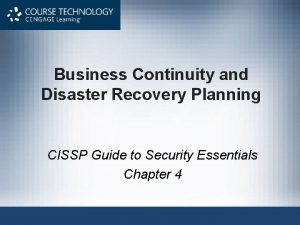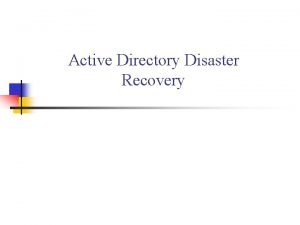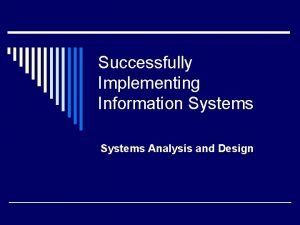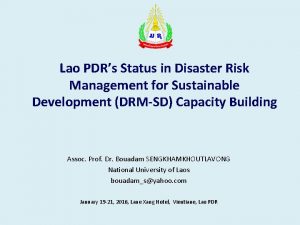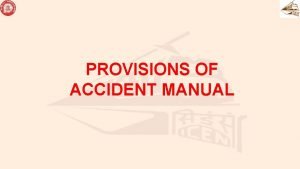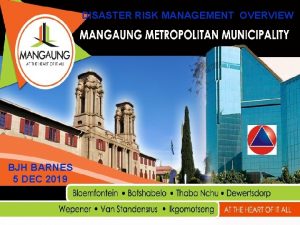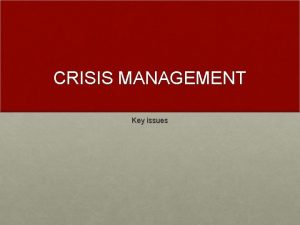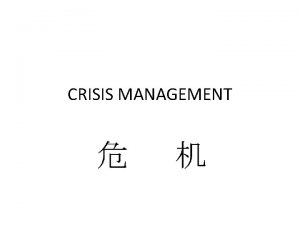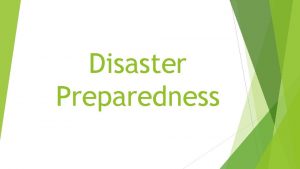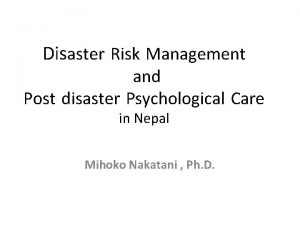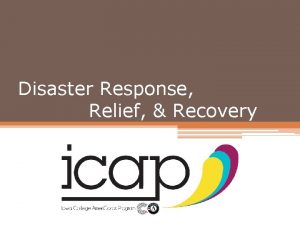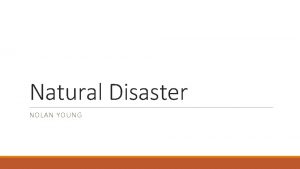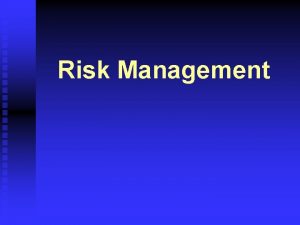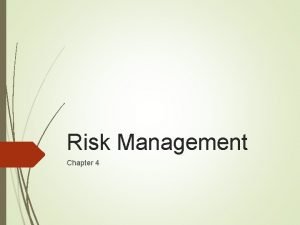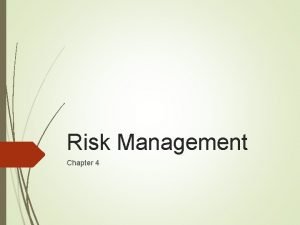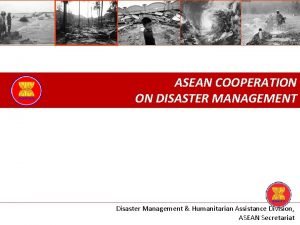Crisis Management Disaster Planning Eric R Paulsen Risk












































- Slides: 44

Crisis Management & Disaster Planning Eric R. Paulsen, Risk Manager www. pcocinsurance. com

What is Crisis Management? 1. Webster’s Definition: “Crisis, a turning point, as in a sequence of events, for better or worse. ” 2. Therefore, crisis management is the act or process of managing a crisis to prevent (if possible) and reduce the impact of catastrophic losses to the organization

September 11, 2001 Opened a lot of eyes

• • Emergency Preparedness / Crisis Management has become a headline issue Terrorist attacks – NYC: September 11, 2001 WTC attacks – Madrid: March 11, 2004 train bombings – London: July 8, 2005 subway bombings Blackouts – 2001 Gov Gray Davis Rolling Blackouts – Northeastern North America: August 14, 2003 – Los Angeles: September 12, 2005 Urban Fires – Almost every year in California Urban Mudslides – Almost every year in California Earthquakes – 89 Loma Prieta and 94 Northridge Earthquake Incidental Events (Tempest in a tea cup) – 1992 Rodney King Riots Pandemic Influenza – Significant media coverage began in 2005 Communication failed, Congress told


Imagine you or your employee is in this vehicle? Julian Mc. Cormick’s Honda Civic

Bowie Student Trapped 8 Days Details Pain, Survival Tactics By Avis Thomas-Lester Washington Post Staff Writer Tuesday, September 11, 2007; A 01 As Julian Mc. Cormick recalls it, he lay in and out of consciousness for eight days and seven nights, hot, sticky and bloody with not a clue as to what day it was or how he ended up trapped in his overturned car at the bottom of a steep embankment in Prince George's County. To survive, he ate a fish he caught with his hands and used his high-top sneaker to drink water from the creek, the 18 -year-old Bowie State University student told his parents. When he finally was able to muster the strength, he cut his seat belt using a small knife he had in his car, forced his door open and then dragged himself by his elbows, his body racked with pain, 30 feet up to the shoulder of the road hoping that someone would see him and rescue him. Someone did. "We've got him back, and we are so glad!" his ecstatic mother said yesterday in an interview. "He's doing great. " As their son recovered at Washington Hospital Center yesterday, Peggy and James Mc. Cormick tried to piece together the circumstances of their son's disappearance and recovery and questioned why police had not done more to


Phase of a Crisis Pre-loss and loss Threat Warning Impact Threat = Nothing has happened, but you have a reasonable probability that it could happen. Warning = The occurrence is imminent Impact = When the event is occurring

5 Steps to Crisis Management 1) 2) 3) 4) 5) Planning Preparedness Prevention Response Recovery

The Cycle of Disaster Management Risk management increases coping capacity, builds resilience. proactive reactive Crisis management treats the symptoms, not the causes.

1) Planning: Pre-Crisis/Disaster • Organizational Team • Structure: upper management, coordinators and response team. • Composition: all departments • Characteristics: need people with expertise, authority to implement plans, physical and psychological abilities, leadership…

1) Planning: Pre-Crisis/Disaster • First activity is pre-planning: brainstorm, consider all possible disasters (use outside resources) and then rank the disasters. • Consider the source of the disaster perils: Source = natural, human, economic Time = length of warning, seasons, business peaks and valleys Controls = Pre-loss/Pre-event and Post-loss/Postevent

1) Planning: Pre-Crisis Planning • List potential crisis/emergencies/disasters – Previously experienced in the pest control industry – Previously experienced in your community/state – Consider – historical, geographical, technological, human error, physical failure, economic, almost everything.

1) Planning: Correlation Chart Significant Slight Severe Almost Nil Slight Moderate Definite

1) Planning: Think about critical products, services, operations • • Operations, equipment, personnel Electricity, water, gas, telecommunications In-house products and services Products, and services supplied by others. (subcontractors, vendors)

1) Planning: Some Potential Crisis • Fumigation Death • • Employee runs over a • child • • Employee is killed by • electrocution, auto • accident, fall or other • means. • Key Employee scandal • • Fire at your facility • • Spill • • Civil Unrest (Rodney King Riots) Death of the owner/QM Earthquake Fire Terrorism Flood Power outage – can run fans or aerate fumigation Change in economy Pandemic Fire, flood or other catastrophe at clients property. You may have some responsibility for response and recovery.

1) Planning: Correlation Chart Death of Owner Severe Significant Slight Power outage impact to fume Tech quits with no notice embezzlement Almost Nil Slight Moderate Definite

1) Planning: Assessing your current • Risk management plan situation • • • Employee handbooks Phone trees (contacting employees & their families) Insurance programs Hazmat plans Safety manuals Security procedures – how do you identify your employees to your customers or public Contracts – what are your obligations to your customers Vendors, - do you have back ups. Fire protection plans Evacuation plans Communication plans

2) Preparing • Establishing the risks, your plan, your procedures, documentation, developing and gathering resources, training, drills, etc.

2) Preparing: Available Resources • • FEMA State Office of Emergency Services Local OES / CERT and others Telephone Company American Red Cross Fire Department Etc….

2) Preparing: Resource Requirements • Management commitment • $$$ • Supplies, water, first-aid, fire extinguishers, gloves, spill kits, alternative communications • Alternate premises • Equipment • More…

2) Preparing: Communications Crisis Information Kit • Lists of team members, (org chart, consider backups) • Phone numbers • Maps • Evacuation routes • Emergency procedures • Information outpost External & Internal Comms • External: informing the public/customers what they can or cannot expect from you in a time of disaster. • Internal – informing, educating and training your employees in processes and procedures.

2) Preparing: Organize Your Team • Educate the team so they understand what each peril is and what precedes the peril. (The must understand each peril) • Train all employees on reporting, evacuations, and how to use emergency equipment and supplies. • Drill the team • Develop and review procedures • Find problems with the plan through drills.

2) Preparing: Essential Components Identification Procedures Inspections Safeguarding Training Evacuations Purchasing Communications Education

3) Preventing • Each identified peril or crisis should have an identified counter measure for both loss prevention and for loss reduction. – Are there emergency response and evacuation procedures in place? – What fire prevention and control measures are in place? – What precautions are taken to prevent heat stroke? – What precautions are taken if your area is prone to floods or landslides? – What backup power is needed and available?

3) Prevention – Organize Control Measures by Pre and Post Loss Peril/Crisis Pre-Loss Post Loss Power Outage Install UPS Generators for fumigations Shut down computers Ensure you have enough fuel Earthquake Secure shelves, filing cabinets to wall Secure premises, shut off gas. CEO Scandal Ensure proper behavior, codes of ethics, background checks Honesty, and good public relations with media and customers Death of QM Health of QM – have a back up Operator in place

4) Response • Communication Outpost/control center • Ensure outpost is well stocked with all necessary supplies, equipment and information technology • Ensure an effective well practices communication plan. • Initiate damage assessment – don’t forget details • Initiate coordination efforts

4) Response • Initiate communication efforts (TELL THE TRUTH) • Financial expenditures • Employee/family considerations – PGT Windows in Florida – hurricane Andrew • • Toll free phone # - plane with banner Campsites with facilities Happy employees & customers Great PR

5) Recovery • Activities to be coordinated pursuant to your plan. • Follow priorities list (from your plan) • Ensure safety before resuming operations • Review recovery timelines for each department

5) Recovery • Initiate Salvage efforts • Initiate communications with insurers and customers • Document damage • Security to protect against looting • Control access to site

Some Examples for PCOs And some key related California laws related to your emergency response / crisis management plan.

Death of a QM/Owner Operator • You need to plan for such a possibility • Have a detailed plan for your spouse/heirs • Get a back up Operator – have your spouse get licensed.

Death of a QM/Owner Operator • 8506. (c) In the event of death of a licensee, the executor or administrator of the deceased person may obtain from the board written authorization for such executor or administrator to conduct the business of such deceased licensee for a period not to exceed one year after the date of death for the purpose of winding up or disposing of the structural pest control business of the deceased licensee; but such authorization shall not entitle such executor or administrator to solicit, engage in, or undertake any structural pest control work not already contracted for by such deceased licensee unless a properly classified and licensed operator is employed to manage, supervise, and direct the business.

Emergency Action Plans • Subchapter 7. General Industry Safety Orders Group 1. General Physical Conditions and Structures Orders Article 2. Standard Specifications • § 3220. Emergency Action Plan.

§ 3220. Emergency Action Plan. • (a) Scope and Application. This section applies to all emergency action plans. The emergency action plan shall be in writing, except as provided in the last sentence of subsection (e)(3) of this section, and shall cover those designated actions employers and employees must take to ensure employee safety from fire and other emergencies.

§ 3220. Emergency Action Plan. - CONTINUED • (b) Elements. The following elements, at a minimum, shall be included in the plan: • (1) Emergency escape procedures and emergency escape route assignments; • (2) Procedures to be followed by employees who remain to operate critical plant operations before they evacuate; • (3) Procedures to account for all employees after emergency evacuation has been completed; • (4) Rescue and medical duties for those employees who are to perform them; • (5) The preferred means of reporting fires and other emergencies; and • (6) Names or regular job titles of persons or departments who can be contacted for further information or explanation of duties under the plan.

§ 3220. Emergency Action Plan. - CONTINUED • (c) Alarm System. • (1) The employer shall establish an employee alarm system which complies with Article 165. • (2) If the employee alarm system is used for alerting fire brigade members, or for other purposes, a distinctive signal for each purpose shall be used.

§ 3220. Emergency Action Plan. - CONTINUED • (d) Evacuation. The employer shall establish in the emergency action plan the types of evacuation to be used in emergency circumstances.

§ 3220. Emergency Action Plan. - CONTINUED (e) Training. (1) Before implementing the emergency action plan, the employer shall designate and train a sufficient number of persons to assist in the safe and orderly emergency evacuation of employees. (2) The employer shall advise each employee of his/her responsibility under the plan at the following times:

§ 3220. Emergency Action Plan. - CONTINUED (A) Initially when the plan is developed, (B) Whenever the employee's responsibilities or designated actions under the plan change, and (C) Whenever the plan is changed. (3) The employer shall review with each employee upon initial assignment those parts of the plan which the employee must know to protect the employee in the event of an emergency. The written plan shall be kept at the workplace and made available for employee review. For those employers with 10 or fewer employees the plan may be communicated orally to employees and the employer need not maintain a written plan.

Reporting Deaths & Serious Injuries to the SPCB • § 1970. 4 (b) Any death or serious injury relating to pesticide application or use, whether to a worker or member of the public, shall be reported to the nearest Structural Pest Control Board office immediately. (§ 1970. 4 Pesticide Disclosure Requirement. )

Other Rules • CDPR mandated Heat Safety Training • Injury & Illness Prevention Program (IIPP) • Defensive Driving as part of your IIPP

This is but a QUICK introduction • See www. oes. ca. gov for lots of information • National Fire Protection Act NFPA 1600 Standards.
 George washington crisis management
George washington crisis management It is the disaster equation
It is the disaster equation Barangay disaster risk reduction management plan
Barangay disaster risk reduction management plan Pdrrm act of 2010 graphic organizer
Pdrrm act of 2010 graphic organizer Republic act 10121
Republic act 10121 Chapter 26 crisis and disaster
Chapter 26 crisis and disaster Liquidity measures
Liquidity measures Myasthenic crisis vs cholinergic crisis
Myasthenic crisis vs cholinergic crisis Key risk indicators for vendor management
Key risk indicators for vendor management Risk map
Risk map Integrated research on disaster risk
Integrated research on disaster risk Ladder up risk assessment
Ladder up risk assessment Crisis and emergency risk communication
Crisis and emergency risk communication Risk information sheet in software engineering
Risk information sheet in software engineering Woods runner gary paulsen
Woods runner gary paulsen Petter quist paulsen
Petter quist paulsen Iec standards
Iec standards What is the setting of nightjohn
What is the setting of nightjohn My life in dog years by gary paulsen
My life in dog years by gary paulsen The hatchet book cover
The hatchet book cover Tracker by gary paulsen
Tracker by gary paulsen Third person omniscient
Third person omniscient Jens erik paulsen
Jens erik paulsen Gary paulsen snowball
Gary paulsen snowball Gary paulsen's dog cookie
Gary paulsen's dog cookie Berit smestad paulsen
Berit smestad paulsen Jeanette frazier wikipedia
Jeanette frazier wikipedia Rick dubinsky
Rick dubinsky Marko mertens
Marko mertens Paulsen
Paulsen When was brian robeson born
When was brian robeson born Third person point of view example
Third person point of view example Jan merok paulsen
Jan merok paulsen Bcp steps cissp
Bcp steps cissp Ad disaster recovery planning scenario
Ad disaster recovery planning scenario Disaster recovery planning in system analysis and design
Disaster recovery planning in system analysis and design Perbedaan irp, drp dan bcp
Perbedaan irp, drp dan bcp Conclusion
Conclusion Early warning system in disaster management
Early warning system in disaster management Records management disaster recovery plan
Records management disaster recovery plan What is disaster management
What is disaster management Disaster management centre sri lanka
Disaster management centre sri lanka Civil defence disaster management
Civil defence disaster management Conclusion of disaster management
Conclusion of disaster management Disaster management
Disaster management
